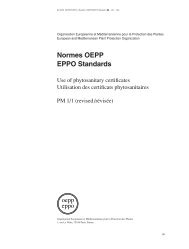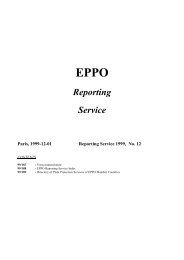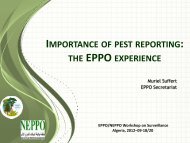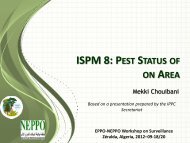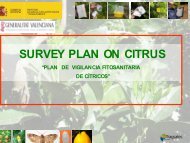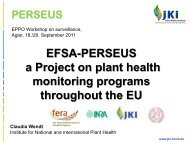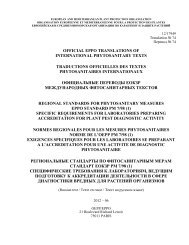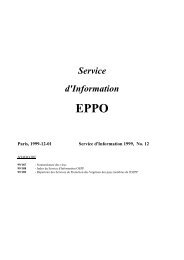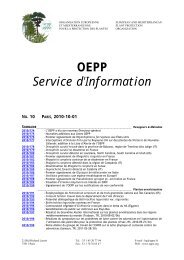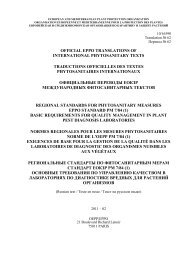EPPO Reporting Service - Lists of EPPO Standards - European and ...
EPPO Reporting Service - Lists of EPPO Standards - European and ...
EPPO Reporting Service - Lists of EPPO Standards - European and ...
You also want an ePaper? Increase the reach of your titles
YUMPU automatically turns print PDFs into web optimized ePapers that Google loves.
21 Bld Richard Lenoir<br />
75011 Paris<br />
ORGANISATION EUROPEENNE<br />
ET MEDITERRANEENNE<br />
POUR LA PROTECTION DES PLANTES<br />
Tel: 33 1 45 20 77 94<br />
Fax: 33 1 70 76 65 47<br />
EUROPEAN AND MEDITERRANEAN<br />
PLANT PROTECTION<br />
ORGANIZATION<br />
<strong>EPPO</strong> <strong>Reporting</strong> <strong>Service</strong><br />
NO. 05 PARIS, 2012-05-01<br />
CONTENTS _______________________________________________________________________ Pests & Diseases<br />
2012/090 - First report <strong>of</strong> Aromia bungii in Germany: addition to the <strong>EPPO</strong> Alert List<br />
2012/091 - First report <strong>of</strong> Tuta absoluta in Qatar<br />
2012/092 - First report <strong>of</strong> Eurytoma plotnikovi in Sicilia, Italy<br />
2012/093 - Outbreak <strong>of</strong> Liriomyza huidobrensis in Finl<strong>and</strong><br />
2012/094 - Outbreak <strong>of</strong> Liriomyza trifolii in Finl<strong>and</strong><br />
2012/095 - Outbreak <strong>of</strong> Impatiens necrotic spot virus in Finl<strong>and</strong><br />
2012/096 - Outbreak <strong>of</strong> Bemisia tabaci in Finl<strong>and</strong><br />
2012/097 - First report <strong>of</strong> Tomato infectious chlorosis virus in Bulgaria<br />
2012/098 - First report <strong>of</strong> Tomato chlorosis virus in Hungary<br />
2012/099 - First report <strong>of</strong> Tomato chlorosis virus in Sudan<br />
2012/100 - „C<strong>and</strong>idatus Liberibacter solanacearum‟ does not occur in Canada<br />
2012/101 - Outbreak <strong>of</strong> Clavibacter michiganensis subsp. sepedonicus in Finl<strong>and</strong><br />
2012/102 - Eradication <strong>of</strong> Acidovorax citrulli from Emilia-Romagna (IT)<br />
2012/103 - First report <strong>of</strong> Plasmopara obducens in Serbia<br />
2012/104 - New data on quarantine pests <strong>and</strong> pests <strong>of</strong> the <strong>EPPO</strong> Alert List<br />
2012/105 - <strong>EPPO</strong> report on notifications <strong>of</strong> non-compliance<br />
CONTENTS ___________________________________________________________________________ Invasive Plants<br />
2012/106 - The IPPC review <strong>of</strong> the global status <strong>of</strong> aquatic plants, their uses <strong>and</strong><br />
the risks they represent<br />
2012/107 - The role <strong>of</strong> eutrophication <strong>of</strong> waters in the management <strong>of</strong> Eichhornia crassipes<br />
in South Africa<br />
2012/108 - Damage <strong>and</strong> benefit caused by weeds<br />
2012/109 - Diversity <strong>of</strong> weeds in highl<strong>and</strong> wheat crops <strong>of</strong> Northern Ethiopia<br />
2012/110 - When are eradication campaigns successful?<br />
2012/111 - A comparative assessment <strong>of</strong> existing policies on invasive species in the<br />
EU Member States <strong>and</strong> in selected OECD countries<br />
2012/112 - Uncertainty in invasive alien species listing<br />
2012/113 - The EU project PRATIQUE outcomes for invasive alien plants<br />
2012/114 - Local projects to manage invasive alien plants in the USA<br />
E-mail: hq@eppo.int<br />
Web: www.eppo.int
<strong>EPPO</strong> <strong>Reporting</strong> <strong>Service</strong> – Pests & Diseases<br />
2012/090 First report <strong>of</strong> Aromia bungii in Germany: addition to the <strong>EPPO</strong> Alert List<br />
The NPPO <strong>of</strong> Germany recently informed the <strong>EPPO</strong> Secretariat <strong>of</strong> the first record <strong>of</strong> Aromia<br />
bungii (Coleoptera: Cerambycidae) on its territory. In July 2011, a single male specimen <strong>of</strong><br />
A. bungii was found on an old damson plum tree (Prunus domestica subsp. insititia) in a<br />
private garden near Kolbermoor in the south <strong>of</strong> Bayern. Exit holes were observed on this<br />
plum tree <strong>and</strong> the garden owners also mentioned that they had observed two other<br />
specimens (A. bungii adults are large black cerambycids with a distinctively red<br />
pronotum). Considering that the life cycle <strong>of</strong> A. bungii may take 2 to 3 years, it was<br />
estimated that A. bungii was introduced into this garden in 2008 or 2009. This finding was<br />
made by scientists unrelated to the NPPO <strong>and</strong> was not brought immediately to the<br />
attention <strong>of</strong> the German NPPO. Therefore, the identity <strong>of</strong> the pest could only be confirmed<br />
<strong>of</strong>ficially in April 2012. The origin <strong>of</strong> this infestation is currently unknown but tracing-back<br />
studies are on-going. Quarantine measures have been imposed on the infested site <strong>and</strong> an<br />
intensive survey is being carried out. Official eradication measures are envisaged.<br />
The pest status <strong>of</strong> Aromia bungii in Germany is <strong>of</strong>ficially declared as: Transient, only at<br />
one location, under eradication.<br />
Aromia bungii (Coleoptera: Cerambycidae) – Redneck longhorned beetle<br />
Why In 2011, the presence <strong>of</strong> Aromia bungii was recorded for the first time in one<br />
location in Germany. Because A. bungii is a fruit tree pest originating from Asia<br />
which was previously not known to occur in the <strong>EPPO</strong> region, the NPPO <strong>of</strong><br />
Germany <strong>and</strong> the <strong>EPPO</strong> Panel on Phytosanitary Measures suggested its addition to<br />
the <strong>EPPO</strong> Alert List.<br />
Where A. bungii is thought to originate from the temperate regions <strong>of</strong> China.<br />
<strong>EPPO</strong> region: Germany (few specimens observed in 2011 in a private garden in<br />
Bayern, under eradication). In 2008, an interception <strong>of</strong> A. bungii had been<br />
reported by the United Kingdom. Three beetles were discovered among wooden<br />
pallets in a warehouse in Bristol but the insect did not establish (no further<br />
specimens or signs <strong>of</strong> presence were found).<br />
Asia: China (present throughout China but more prevalent in the central <strong>and</strong><br />
northern provinces), Korea (Republic <strong>of</strong>), Korea (Peoples‟ Democratic Republic<br />
<strong>of</strong>), Mongolia, Taiwan, Vietnam. Details on its distribution in Asia are generally<br />
lacking, therefore this distribution is only preliminary.<br />
North America: Absent, intercepted only. In July 2008, A. bungii was<br />
intercepted in a manufacturing plant, importing products from China <strong>and</strong><br />
Taiwan, located at the port <strong>of</strong> Seattle (Washington state, US) in July 2008.<br />
On which plants In China, the main host plants are Prunus species (Rosaceae), in particular peach<br />
(Prunus persica) <strong>and</strong> apricot (P. armeniaca), <strong>and</strong> to a lesser extent plum (P.<br />
domestica) <strong>and</strong> cherry (P. avium). The following tree species are also reported to<br />
be host plants <strong>of</strong> A. bungii but without any indication <strong>of</strong> the extent <strong>and</strong> severity<br />
<strong>of</strong> damage: Azadirachta indica (Meliaceae), Bambusa textilis (Poaceae),<br />
Diospyros virginiana (Ebenaceae), Olea europea (olive - Oleaceae), Populus alba<br />
(Salicaceae), Pterocarya stenoptera (Jugl<strong>and</strong>aceae), Punica granatum<br />
(pomegranate - Lythraceae), Schima superba (Theaceae).<br />
Damage Larvae <strong>of</strong> A. bungii bore galleries (17-22 cm long) in the trunk <strong>and</strong> larger lateral<br />
branches, leading to loss <strong>of</strong> fruit production <strong>and</strong> weakening <strong>of</strong> the trees. Exit<br />
holes <strong>and</strong> frass are signs <strong>of</strong> the presence <strong>of</strong> the pest. Larvae infest the<br />
subcortical area beneath the bark <strong>and</strong> the sapwood (less commonly the<br />
heartwood). A. bungii attacks healthy to slightly stressed trees. Adults are black<br />
cerambycids (approximately 40 mm long) with glossy elytra <strong>and</strong> a distinctively<br />
red pronotum (although some forms may be completely black).<br />
Pictures can be viewed on the Internet:<br />
http://www.biolib.cz/en/image/id48689/<br />
http://www.biolib.cz/en/image/id48688/<br />
http://www.s5461.net/kj/hjkj/dwy/dwjs/201001/55456.asp<br />
2
<strong>EPPO</strong> <strong>Reporting</strong> <strong>Service</strong> – Pests & Diseases<br />
Data on the biology <strong>of</strong> A. bungii is generally lacking. In Northern China, it is<br />
reported that one generation may take 2 to 3 years, the insect overwintering at<br />
various larval stages inside galleries. Larvae start feeding in early or mid-April<br />
with a peak <strong>of</strong> feeding activity from May to June. Pupation takes place at the<br />
end <strong>of</strong> June <strong>and</strong> adults emerge from late June until early August. Eggs are laid in<br />
bark crevices on the trunk <strong>and</strong> main branches at the beginning <strong>of</strong> July <strong>and</strong> hatch<br />
after 8-9 days (mid-July). Adults emit a particular odour to keep natural enemies<br />
at bay when they are disturbed.<br />
Dissemination No data is available on the natural spread <strong>of</strong> A. bungii, but as in the case for the<br />
other cerambycids (e.g. Anoplophora spp.) it is considered that adults can only<br />
fly over rather short distances. The two incidents reported from the United<br />
Kingdom <strong>and</strong> USA strongly suggested that imports <strong>of</strong> goods from Asia could<br />
transport the pest to other continents. The most likely pathways are suspected<br />
to be wood packaging material (because Populus alba is reported to be a host<br />
plant) <strong>and</strong> trade <strong>of</strong> nursery plants (ornamentals, fruit tree species).<br />
Pathway Plants for planting, wood, wood packaging material from countries where A.<br />
bungii occurs.<br />
Possible risks Prunus species are widely grown across the <strong>EPPO</strong> region for ornamental purposes<br />
<strong>and</strong> fruit production, <strong>and</strong> are <strong>of</strong> major economic importance. In China, A. bungii<br />
is considered to be a common pest <strong>of</strong> peach <strong>and</strong> apricot. The fact that it may<br />
also attack other important trees cultivated for fruit (e.g. olive, pomegranate) or<br />
wood production (e.g. Populus alba) adds to the risk. Data is lacking on the<br />
possible control methods against the pest, but as with control methods against<br />
other tree borers, they are most likely to be difficult to apply in practice. In the<br />
Chinese literature, there are reports <strong>of</strong> trials using nematodes (e.g. Steinernema<br />
carpocapsae, S. feltiae) as biocontrol agents against A. bungii, but it is not<br />
known how extensively <strong>and</strong> effectively these treatments can be used in the field.<br />
Considering the length <strong>of</strong> the biological cycle <strong>and</strong> the hidden behaviour <strong>of</strong> larvae,<br />
A. bungii is difficult to detect on infested plants or wood. An Express-PRA was<br />
conducted in Germany <strong>and</strong> concluded that despite a general lack <strong>of</strong> information<br />
about A. bungii, this pest probably has the potential to establish in most parts <strong>of</strong><br />
the <strong>EPPO</strong> region <strong>and</strong> presents a high risk.<br />
Sources Burmeister EG, Hendrich L, Balke M (2012) Der Asiatische Moschusbock Aromia bungii (Faldermann,<br />
1835) – Erstfund für Deutschl<strong>and</strong> (Coleoptera: Cerambycidae). Nachrichtenblatt der bayerischen<br />
Entomologen 61(1/2), 29-32.<br />
JKI (2012-02-27) Express PRA zu Aromia bungii by Schrader G <strong>and</strong> Schröder T. (in German).<br />
http://pflanzengesundheit.jki.bund.de/dokumente/upload/0ec1b_aromia_bungii-ex-pra.pdf<br />
Liu Z, Zhang GI, Li L, Zong J (1993) [Biological control <strong>of</strong> peach rednecked longicorn Aromia bungii<br />
with entomopathogenic nematodes]. Chinese Journal <strong>of</strong> Biological Control 9(4), p 186 (in Chinese).<br />
NPPO <strong>of</strong> Germany (2012-04).<br />
INTERNET<br />
A&F University, Yangling, Shaanxi province, China Teaching syllabus <strong>of</strong> Northwest A&F University.<br />
Chapter 14. Branch borers by Wu Junxiang <strong>and</strong> Li Yiping.<br />
http://210.27.80.89/2005/nongyekongchun/page/Agricultural%20Entomplogy%20(PDF)/Chapter%20<br />
14%20%20Branch%20borers.pdf<br />
Barcoding Fauna Bavarica. Der Asiatische Moschusbock. Ein bayerischer Neubürger: Der Asiatische<br />
Moschusbock Aromia bungii (Coleoptera, Cerambycidae) – Neumeldung für Deutschl<strong>and</strong>.<br />
http://www.faunabavarica.de/art-des-monats/moschusbock<br />
Fera News <strong>of</strong> 2010-09-24. Psacothea hilaris (Coleoptera: Cerambycidae) <strong>and</strong> other exotic longhorn<br />
beetles by S. Reid <strong>and</strong> R. Cannon. http://www.fera.defra.gov.uk/showNews.cfm?id=454<br />
USDA/APHIS/PPQ. New Pest Advisory Group (June 2009) NPAG Report, Aromia bungii (Faldermann).<br />
Redneck longhorned beetle, Coleoptera/Cerambycidae.<br />
http://www.scribd.com/doc/74311967/Aromia-Bungii-Report<br />
<strong>EPPO</strong> RS 2012/090<br />
Panel review date - Entry date 2012-05<br />
3
2012/091 First report <strong>of</strong> Tuta absoluta in Qatar<br />
<strong>EPPO</strong> <strong>Reporting</strong> <strong>Service</strong> – Pests & Diseases<br />
In March 2011, Tuta absoluta (Lepidoptera: Gelechiidae – <strong>EPPO</strong> A2 List) was found for the<br />
first time in Qatar at Al-Khor, an area located in the north <strong>of</strong> the country. The infestation<br />
was observed on glasshouse tomato plants growing in two neighbouring farms. Some<br />
tomato plants growing in an open field in the same site were also found to be infested by<br />
the insect. An eradication programme has been implemented by removing <strong>and</strong> burning all<br />
infested plants, spraying pesticides, pest monitoring using water <strong>and</strong> pheromone traps. The<br />
possible source <strong>of</strong> infestation may be from tomato fruits imported from outside the<br />
country. Precautions are being taken to prevent any further spread <strong>of</strong> the insect (i.e.<br />
prohibition to move plant material from the infested site including composted material,<br />
disinfection <strong>of</strong> all equipment used for plant destruction, warning notices for visitors <strong>and</strong><br />
elimination <strong>of</strong> all residues <strong>of</strong> previous plants <strong>and</strong> wild host weeds <strong>of</strong> the solanaceous<br />
family). This is the first report <strong>of</strong> Tuta absoluta in Qatar.<br />
Source: Personal communication (2012-05) with Dr Emad Hussain Al-Turaihi, Agricultural<br />
Affairs Department, Ministry <strong>of</strong> Environment, P.O. Box 1966. Doha-Qatar. E-mail:<br />
emadhussain30@yahoo.com<br />
Additional key words: new record Computer codes: GNORAB, QA<br />
2012/092 First report <strong>of</strong> Eurytoma plotnikovi in Sicilia, Italy<br />
In spring 2011, pistachio nuts (Pistacia vera) infested by larvae <strong>of</strong> an unidentified wasp<br />
were collected from several orchards located in central-western Sicilia, Italy. Larvae were<br />
reared in the laboratory <strong>and</strong> emerging adults were identified as Eurytoma plotnikovi<br />
(Hymenoptera: Eurytomidae). E. plotnikovi originates from China where it is reported to<br />
develop in nuts <strong>of</strong> Pistacia chinensis (an ornamental species with non-edible nuts). This<br />
seed wasp has also been recorded outside China in Greece, Iran, Israel, Kyrgyzstan,<br />
Tunisia, Turkmenistan, <strong>and</strong> Turkey. In the pistachio orchards studied in Sicilia, E.<br />
plotnikovi was found in mixed populations with another seed wasp, Megastigmus pistaciae,<br />
a native species. Damage caused by E. plotnikovi has been noticed by growers since 2009<br />
but was confused with that caused by M. pistaciae. The authors noted that considering the<br />
importance <strong>of</strong> the pistachio industry in eastern Sicilia (where E. plotnikovi has not been<br />
found), it was desirable to prevent its further spread across the isl<strong>and</strong>.<br />
Source: Longo S, Suma P (2011) First report <strong>of</strong> Eurytoma plotnikovi Nik. (Hymenoptera,<br />
Eurytomidae), a seed parasite <strong>of</strong> pistachio, in Sicily (Italy). Journal <strong>of</strong> Entomological<br />
<strong>and</strong> Acarological Research, Serie II 43(3), 333-336.<br />
Additional key words: new record Computer codes: EURTPL, IT<br />
4
2012/093 Outbreak <strong>of</strong> Liriomyza huidobrensis in Finl<strong>and</strong><br />
<strong>EPPO</strong> <strong>Reporting</strong> <strong>Service</strong> – Pests & Diseases<br />
The NPPO <strong>of</strong> Finl<strong>and</strong> recently informed the <strong>EPPO</strong> Secretariat <strong>of</strong> an outbreak <strong>of</strong> Liriomyza<br />
huidobrensis (Diptera: Agromyzidae - <strong>EPPO</strong> A2 List) on its territory. On 2012-04-26, L.<br />
huidobrensis was caught in sticky traps placed in one glasshouse growing various bedding<br />
plants. The origin <strong>of</strong> the pest remains unknown. Eradication measures were immediately<br />
implemented.<br />
The pest status <strong>of</strong> Liriomyza huidobrensis in Finl<strong>and</strong> is <strong>of</strong>ficially declared as: Present,<br />
under eradication.<br />
Source: NPPO <strong>of</strong> Finl<strong>and</strong> (2012-04).<br />
Additional key words: detailed record Computer codes: LIRIHU, FI<br />
2012/094 Outbreak <strong>of</strong> Liriomyza trifolii in Finl<strong>and</strong><br />
The NPPO <strong>of</strong> Finl<strong>and</strong> recently informed the <strong>EPPO</strong> Secretariat <strong>of</strong> an outbreak <strong>of</strong> Liriomyza<br />
trifolii (Diptera: Agromyzidae - <strong>EPPO</strong> A2 List) on its territory. On 2012-04-04, L. trifolii was<br />
found on Gerbera plants in one glasshouse producing cut flowers (where the pest had<br />
never been found before). The origin <strong>of</strong> the pest remains unknown. Eradication measures<br />
were immediately implemented.<br />
The pest status <strong>of</strong> Liriomyza trifolii in Finl<strong>and</strong> is <strong>of</strong>ficially declared as: Present, under<br />
eradication.<br />
Source: NPPO <strong>of</strong> Finl<strong>and</strong> (2012-04).<br />
Additional key words: detailed record Computer codes: LIRITR, FI<br />
2012/095 Outbreak <strong>of</strong> Impatiens necrotic spot virus in Finl<strong>and</strong><br />
The NPPO <strong>of</strong> Finl<strong>and</strong> recently informed the <strong>EPPO</strong> Secretariat <strong>of</strong> an outbreak <strong>of</strong> Impatiens<br />
necrotic spot virus (Tospovirus, INVS - <strong>EPPO</strong> A2 List) on its territory. On 2012-02-23, INSV<br />
was detected on pot plants <strong>of</strong> Begonia, Impatiens hawkeri <strong>and</strong> Kalanchoe blossfeldiana at<br />
1 place <strong>of</strong> production. Within the production site, the virus was efficiently transmitted by<br />
Frankliniella occidentalis but the origin <strong>of</strong> the infestation remains unknown. Eradication<br />
measures were immediately implemented.<br />
The pest status <strong>of</strong> Impatiens necrotic spot virus in Finl<strong>and</strong> is <strong>of</strong>ficially declared as:<br />
Present, under eradication.<br />
Source: NPPO <strong>of</strong> Finl<strong>and</strong> (2012-04).<br />
Additional key words: detailed record Computer codes: INSV00, FI<br />
5
2012/096 Outbreak <strong>of</strong> Bemisia tabaci in Finl<strong>and</strong><br />
<strong>EPPO</strong> <strong>Reporting</strong> <strong>Service</strong> – Pests & Diseases<br />
The NPPO <strong>of</strong> Finl<strong>and</strong> recently informed the <strong>EPPO</strong> Secretariat <strong>of</strong> an outbreak <strong>of</strong> Bemisia<br />
tabaci (Hemiptera: Aleyrodidae - <strong>EPPO</strong> A2 List) on its territory. On 2012-04-16, B. tabaci<br />
was caught in yellow sticky traps placed in 2 glasshouses growing a large variety <strong>of</strong> plant<br />
species. The origin <strong>of</strong> the pest remains unknown. Eradication measures were immediately<br />
implemented.<br />
The pest status <strong>of</strong> Bemisia tabaci in Finl<strong>and</strong> is <strong>of</strong>ficially declared as: Present, under<br />
eradication.<br />
Source: NPPO <strong>of</strong> Finl<strong>and</strong> (2012-04).<br />
Additional key words: detailed record Computer codes: BEMITA, FI<br />
2012/097 First report <strong>of</strong> Tomato infectious chlorosis virus in Bulgaria<br />
In Bulgaria, during a recent survey <strong>of</strong> tomato crops conducted near Plovdiv, symptoms <strong>of</strong><br />
interveinal leaf yellowing <strong>and</strong> necrosis were observed on tomato plants (Solanum<br />
lycopersicum cv. „Velocity‟) in one glasshouse. Most <strong>of</strong> the plants were severely affected<br />
<strong>and</strong> yield was drastically reduced. The crop was also heavily infested by Trialeurodes<br />
vaporariorum. Laboratory analysis (serological <strong>and</strong> molecular tests) confirmed the<br />
presence <strong>of</strong> Tomato infectious chlorosis virus (Crinivirus, TICV – <strong>EPPO</strong> A2 List). This is the<br />
first time that TICV is reported in Bulgaria. The origin <strong>of</strong> this infection remains unknown<br />
but it is suspected that the virus may have spread from Greece (as Greek <strong>and</strong> Bulgarian<br />
isolates studied were closely related) via the whitefly vector or trade <strong>of</strong> infected<br />
propagation material.<br />
The situation <strong>of</strong> Tomato infectious chlorosis virus in Bulgaria can be described as follows:<br />
Present, detected in one glasshouse near Plovdiv.<br />
Source: Pasev G, Radeva V, Lostova D (2012) First report <strong>of</strong> Tomato infectious chlorosis virus<br />
on tomato in Bulgaria. Journal <strong>of</strong> Phytopathology 160(3), 115-166.<br />
Additional key words: new record Computer codes: TICV00, BG<br />
2012/098 First report <strong>of</strong> Tomato chlorosis virus in Hungary<br />
In 2007, an unusual disease <strong>of</strong> tomato (Solanum lycopersicum) was observed in some<br />
glasshouses in Tömörkény (Csongrád county) in Southern Hungary. Affected plants were<br />
chlorotic <strong>and</strong> stunted, <strong>and</strong> their leaves showed mottling, asymmetric interveinal yellowing<br />
<strong>and</strong> necrosis. Laboratory analysis (DAS-ELISA, RT-PCR, electron microscopy) confirmed the<br />
presence <strong>of</strong> Tomato chlorosis virus (Crinivirus, ToCV - <strong>EPPO</strong> A2 List) in affected tomato<br />
plants. This is the first time that ToCV is reported from Hungary.<br />
The situation <strong>of</strong> Tomato chlorosis virus in Hungary can be described as follows: Present,<br />
first found in 2007 in glasshouse tomatoes near Tömörkény (Csongrád county).<br />
Source: Bese G, Bóka K, Krizbai L, Tákacs AP (2011) [First occurrence <strong>of</strong> Tomato chlorosis<br />
virus in tomato in Hungary]. Növényvédelem 47(9), 377-380 (in Hungarian).<br />
Bese G, Bóka K, Krizbai L, Tákacs AP (2011) First report <strong>of</strong> Tomato chlorosis virus in<br />
tomato from Hungary. Plant Disease 95(3), p 363.<br />
Additional key words: new record Computer codes: TOCV00, HU<br />
6
2012/099 First report <strong>of</strong> Tomato chlorosis virus in Sudan<br />
<strong>EPPO</strong> <strong>Reporting</strong> <strong>Service</strong> – Pests & Diseases<br />
In March 2011, symptoms resembling those <strong>of</strong> Tomato chlorosis virus <strong>and</strong> Tomato<br />
infectious chlorosis virus (both Crinivirus, ToCV <strong>and</strong> TICV - <strong>EPPO</strong> A2 List) were observed in<br />
tomato plants (Solanum lycopersicum cv. „Castle Rock‟) in 3 adjacent glasshouses <strong>of</strong> the<br />
Agricultural Research Cooperation at Wad Medani (Gezira state), Sudan. The presence <strong>of</strong><br />
Bemisia tabaci (Hemiptera: Aleyrodidae – <strong>EPPO</strong> A2 List) was also observed in these<br />
glasshouses. Leaf samples were collected from symptomatic plants <strong>and</strong> tested in the<br />
laboratory (dot-blot hybridization, RT-PCR, sequencing). The presence <strong>of</strong> ToCV was<br />
confirmed in diseased tomato plants. This is the first time that ToCV is reported from<br />
Sudan. It is also noted that yellowing symptoms have been sporadically observed during the<br />
last few years in open-field tomato crops in the state <strong>of</strong> Gezira. However, further studies<br />
are needed to determine the prevalence <strong>and</strong> economic impact <strong>of</strong> ToCV in tomato crops in<br />
Sudan.<br />
The situation <strong>of</strong> Tomato chlorosis virus in Sudan can be described as follows: Present, first<br />
found in 2011 in glasshouse tomatoes (3 glasshouses <strong>of</strong> a research station), Gezira<br />
state.<br />
Source: Fiallo-Olivé E, Hamed AA, Moriones E, Navas-Castillo J (2011) First report <strong>of</strong> Tomato<br />
chlorosis virus infecting tomato in Sudan. Plant Disease 95(2), p 1592.<br />
Additional key words: new record Computer codes: TOCV00, SD<br />
2012/100 ‘C<strong>and</strong>idatus Liberibacter solanacearum’ does not occur in Canada<br />
The NPPO <strong>of</strong> Canada <strong>of</strong>ficially declared that „C<strong>and</strong>idatus Liberibacter solanacearum‟ (<strong>EPPO</strong><br />
Alert List) has never been detected in Canada on tomato or potato. The record <strong>of</strong> „Ca. L.<br />
solanacearum‟ in Alberta appearing in <strong>EPPO</strong> RS 2009/089 is considered erroneous. In<br />
addition, the psyllid vector (Bactericera cockerelli) is not established in Canada. It may be<br />
found in glasshouses, but outdoor populations only occur late in the season after migration<br />
from the USA <strong>and</strong> cannot overwinter under the Canadian climatic conditions.<br />
Source: NPPO <strong>of</strong> Canada (2012-04).<br />
Additional key words: denied record Computer codes: LIBEPS, PARZCO, CA<br />
2012/101 Outbreak <strong>of</strong> Clavibacter michiganensis subsp. sepedonicus in Finl<strong>and</strong><br />
The NPPO <strong>of</strong> Finl<strong>and</strong> recently informed the <strong>EPPO</strong> Secretariat <strong>of</strong> an outbreak <strong>of</strong> Clavibacter<br />
michiganensis subsp. sepedonicus (<strong>EPPO</strong> A2 List) on its territory. The bacterium was<br />
detected in 2 samples collected from 2 ware potato fields (Solanum tuberosum cv.<br />
„Asterix‟) in one farm during the 2011 national survey. The extent <strong>of</strong> the probable<br />
contamination has been determined as being the entire area <strong>of</strong> the farm. Seven other<br />
farms that have used the same seed potato lot were inspected but the bacterium was not<br />
detected. On the infected farm, phytosanitary measures were applied in accordance with<br />
EU Directive 2006/56/EC.<br />
The situation <strong>of</strong> Clavibacter michiganensis subsp. sepedonicus in Finl<strong>and</strong> can be described<br />
as follows: Present, restricted distribution, under <strong>of</strong>ficial control.<br />
Source: NPPO <strong>of</strong> Finl<strong>and</strong> (2012-05).<br />
Additional key words: detailed record Computer codes: CORBSE, FI<br />
7
<strong>EPPO</strong> <strong>Reporting</strong> <strong>Service</strong> – Pests & Diseases<br />
2012/102 Eradication <strong>of</strong> Acidovorax citrulli from Emilia-Romagna (IT)<br />
In Italy, the presence <strong>of</strong> Acidovorax citrulli (<strong>EPPO</strong> Alert List) was reported in October 2009<br />
in a single melon field (Cucurbita melo cv. „Giusto‟) in the province <strong>of</strong> Ferrara, Emilia-<br />
Romagna region (see <strong>EPPO</strong> RS 2010/059). Because the bacterium was detected at the end<br />
<strong>of</strong> the growing season, the grower was asked to apply herbicides <strong>and</strong> not to replant melons<br />
in the infected field. In 2010 <strong>and</strong> 2011, a monitoring programme (general surveillance <strong>and</strong><br />
targeted surveys) was carried out in Emilia-Romagna <strong>and</strong> did not detect A. citrulli. In<br />
March 2012, the NPPO <strong>of</strong> Italy <strong>of</strong>ficially declared the successful eradication <strong>of</strong> A. citrulli<br />
from Emilia-Romagna. However, the NPPO pointed out that because melon <strong>and</strong><br />
watermelon seeds continue to be imported from areas where the bacterium occurs, there<br />
is a high risk <strong>of</strong> new introductions, as this has already been illustrated by the detection <strong>of</strong><br />
another outbreak in 2010 in Sardegna on grafted melon plants (still under eradication - see<br />
<strong>EPPO</strong> RS 2011/150). Therefore, monitoring programmes on A. citrulli will continue in Italy.<br />
The pest status <strong>of</strong> Acidovorax citrulli in Emilia-Romagna is <strong>of</strong>ficially declared as: Absent,<br />
single case eradicated. The general surveillance as well as a targeted survey have not<br />
shown further foci in the two following years after the report. The monitoring <strong>and</strong> the<br />
survey will continue in the next growing seasons.<br />
Source: NPPO <strong>of</strong> Italy (2012-03).<br />
Additional key words: eradication Computer codes: PSDMAC, IT<br />
2012/103 First report <strong>of</strong> Plasmopara obducens in Serbia<br />
In May 2010, symptoms resembling those <strong>of</strong> downy mildew were observed on Impatiens<br />
walleriana plants in a glasshouse near Mionica (Kolubarski district), in Serbia. Affected<br />
plants were severely stunted with mild mottling <strong>and</strong> yellowing on the upper leaf surface.<br />
The lower leaf surface was completely covered with a thick white fungus-like growth.<br />
Symptomatic leaves wilted very rapidly <strong>and</strong> fell prematurely, leaving plants with only a<br />
few <strong>of</strong> the youngest leaves <strong>and</strong> poorly (if any) developed flowers. Disease incidence was<br />
very high (nearly 100%), resulting in losses <strong>of</strong> more than 90%. Laboratory analysis<br />
(morphology, PCR, pathogenicity tests) confirmed the presence <strong>of</strong> Plasmopara obducens<br />
(formerly <strong>EPPO</strong> Alert List) in diseased plants. This is the first time that P. obducens is<br />
reported from Serbia. It is concluded that surveys are needed to determine the distribution<br />
<strong>and</strong> incidence <strong>of</strong> P. obducens on impatiens which is one <strong>of</strong> the most popular ornamentals in<br />
Serbia.<br />
Source: Bulajić A, Vučurović A, Stanković I, Ristić D, Jović J, Stojković B, Krstić B (2011)<br />
First report <strong>of</strong> Plasmopara obducens on Impatiens walleriana in Serbia. Plant<br />
Disease 95(4), p 490.<br />
Additional key words: new record Computer codes: PLASOB, RS<br />
8
<strong>EPPO</strong> <strong>Reporting</strong> <strong>Service</strong> – Pests & Diseases<br />
2012/104 New data on quarantine pests <strong>and</strong> pests <strong>of</strong> the <strong>EPPO</strong> Alert List<br />
By searching through the literature, the <strong>EPPO</strong> Secretariat has extracted the following new<br />
data concerning quarantine pests <strong>and</strong> pests included on the <strong>EPPO</strong> Alert List. The situation<br />
<strong>of</strong> the pest concerned is indicated in bold, using the terms <strong>of</strong> ISPM no. 8.<br />
� New records<br />
In Spain, Blastopsylla occidentalis (Hemiptera: Psyllidae) was detected for the first time in<br />
November 2009 on nursery plants <strong>of</strong> Eucalyptus camaldulensis in the province <strong>of</strong> Huelva<br />
(Andalucía). Further investigations showed that this eucalyptus psyllid also occurred in<br />
several other localities <strong>of</strong> the Huelva province, as well as in the Algarve, in Portugal. For<br />
the moment, only low populations <strong>of</strong> B. occidentalis were found (<strong>of</strong>ten co-existing with<br />
another introduced psyllid, Glycaspis brimblecombei) <strong>and</strong> no particular damage was<br />
observed (Pérez-Otero et al., 2011).<br />
In the Czech Republic, the presence <strong>of</strong> Cydalima perspectalis (Lepidoptera: Crambidae –<br />
formerly <strong>EPPO</strong> Alert List) was detected for the first time during faunistic studies carried<br />
out in the Podyjí National Park (Šumpich, 2011).<br />
In Hungary, Cydalima perspectalis (Lepidoptera: Crambidae – formerly <strong>EPPO</strong> Alert List) was<br />
found for the first time in September 2011 in the Botanical Garden <strong>of</strong> the University <strong>of</strong><br />
Sopron. The insect was caught in a light trap. The authors <strong>of</strong> this paper also report the<br />
presence <strong>of</strong> C. perspectalis in Slovenia on the basis <strong>of</strong> a personal communication with Dr<br />
Matjaž Jež (Sáfián <strong>and</strong> Horváth, 2011).<br />
In Turkey, Cydalima perspectalis (Lepidoptera: Crambidae – formerly <strong>EPPO</strong> Alert List) was<br />
found for the first time in June 2011 in the campus <strong>of</strong> the Istanbul University. Further<br />
investigations detected the pest in other parks <strong>and</strong> gardens <strong>of</strong> the <strong>European</strong> side <strong>of</strong><br />
Istanbul on Buxus sempervirens <strong>and</strong> B. sempervirens cv. „Aureovariegata‟ (Hizal et al.,<br />
2012).<br />
Stephanitis takeyai (Heteroptera: Tingidae – formerly <strong>EPPO</strong> Alert List) was found for the<br />
first time in Hungary in July 2011. The pest was observed at Szombathely in the Kámoni<br />
Arboretum, feeding on the underside <strong>of</strong> leaves <strong>of</strong> Pieris japonica (Vétek et al., 2012).<br />
Source: Hizal E, Kose M, Yesil C, Kaynar D (2012) The new pest Cydalima perspectalis<br />
(Walker, 1859) (Lepidoptera: Crambidae) in Turkey. Journal <strong>of</strong> Animal <strong>and</strong><br />
Veterinary Advances 11(3), 400-403.<br />
Pérez-Otero RJ, Mansilla P, Borrajo P, Ruiz F (2011) First report <strong>of</strong> Blastopsylla<br />
occidentalis Taylor (Homoptera: Psyllidae) in the Iberian Peninsula. Boletín de<br />
Sanidad Vegetal – Plagas 37(2), 139-144.<br />
Sáfián S, Horváth B (2011) Box tree moth - Cydalima perspectalis (Walker, 1859),<br />
new member in the Lepidoptera fauna <strong>of</strong> Hungary (Lepidoptera: Crambidae).<br />
Natura Somogyiensis 19, 245-246.<br />
Šumpich J (2011) [Die Schmetterlinge der Nationalparke Podyjí und Thayatal].<br />
Správa Národního parku Podyjí, Znojmo (CZ), 428 pp (in Czech).<br />
http://www.nppodyji.cz/uploads/soubory/publikace/Sumpich_2011_Motyli_Podyji_<br />
small.pdf<br />
Vétek G, Kondorosy E, Maráczi L (2012) [First record <strong>of</strong> the <strong>and</strong>romeda lace bug<br />
(Stephanitis takeyai Drake et Maa) (Heteroptera: Tingidae) in Hungary.<br />
Növényvédelem 48(1), 21-26 (in Hungarian).<br />
Additional key words: new records Computer codes: BLSPOC, DPHNPE, STEPTA, CZ, ES, HU, PT, SI, TR<br />
9
2012/105 <strong>EPPO</strong> report on notifications <strong>of</strong> non-compliance<br />
<strong>EPPO</strong> <strong>Reporting</strong> <strong>Service</strong> – Pests & Diseases<br />
The <strong>EPPO</strong> Secretariat has gathered below the notifications <strong>of</strong> non-compliance for 2011 <strong>and</strong><br />
2012 received since the previous report (<strong>EPPO</strong> RS 2011/250). Notifications have been sent<br />
directly to <strong>EPPO</strong> by Algeria, Azerbaijan, Croatia, <strong>and</strong> via Europhyt for the EU countries <strong>and</strong><br />
Switzerl<strong>and</strong>. The <strong>EPPO</strong> Secretariat has selected notifications <strong>of</strong> non-compliance made<br />
because <strong>of</strong> the detection <strong>of</strong> pests. Other notifications <strong>of</strong> non-compliance due to prohibited<br />
commodities, missing or invalid certificates are not indicated. It must be pointed out that<br />
the report is only partial, as many <strong>EPPO</strong> countries have not yet sent their notifications.<br />
When a consignment has been re-exported <strong>and</strong> the country <strong>of</strong> origin is unknown, the reexporting<br />
country is indicated in brackets. When the occurrence <strong>of</strong> a pest in a given<br />
country is not known to the <strong>EPPO</strong> Secretariat, this is indicated by an asterisk (*).<br />
Pest Consignment Type <strong>of</strong> commodity Country <strong>of</strong> origin Destination nb<br />
Agromyzidae Apium graveolens Vegetables Vietnam Switzerl<strong>and</strong> 1<br />
Ocimum basilicum Vegetables (leaves) Vietnam Germany 3<br />
Bemisia Hypericum Cut flowers Kenya Italy 1<br />
Origanum vulgare Vegetables (leaves) Israel Belgium 1<br />
Bemisia tabaci Anubias barteri Plants for planting Singapore United Kingdom 1<br />
Corchorus Vegetables (leaves) Jordan United Kingdom 1<br />
Cryptocoryne wendtii Plants for planting Singapore United Kingdom 1<br />
Echinodorus Plants for planting Singapore United Kingdom 1<br />
Echinodorus Cut flowers Singapore United Kingdom 1<br />
Eryngium foetidum Vegetables (leaves) Vietnam France 2<br />
Hygrophila salicifolia Plants for planting Thail<strong>and</strong> United Kingdom 1<br />
Ipomoea batatas Vegetables Ghana United Kingdom 1<br />
Limnophila Vegetables (leaves) Vietnam France 1<br />
Limnophila aromatica Vegetables (leaves) Vietnam France 4<br />
Ludwigia palustris Plants for planting Singapore United Kingdom 1<br />
Manihot esculenta Vegetables Congo, Dem. Rep. France 2<br />
Momordica Vegetables Sri Lanka United Kingdom 1<br />
Ocimum Vegetables (leaves) Laos* United Kingdom 1<br />
Ocimum Vegetables (leaves) Malaysia United Kingdom 1<br />
Ocimum basilicum Vegetables (leaves) Colombia Netherl<strong>and</strong>s 1<br />
Ocimum basilicum Vegetables (leaves) Israel Belgium 1<br />
Ocimum basilicum Vegetables (leaves) Israel France 1<br />
Ocimum basilicum Vegetables (leaves) Israel Switzerl<strong>and</strong> 3<br />
Ocimum basilicum Vegetables (leaves) Israel United Kingdom 5<br />
Ocimum basilicum Vegetables (leaves) Malaysia United Kingdom 1<br />
Ocimum basilicum Vegetables (leaves) Nigeria United Kingdom 1<br />
Ocimum basilicum Vegetables (leaves) Spain (Canary Isl.) United Kingdom 2<br />
Ocimum basilicum Vegetables (leaves) USA United Kingdom 1<br />
Ocimum, Solidago Vegetables (leaves) Israel United Kingdom 1<br />
Polygonum odoratum Vegetables (leaves) Vietnam France 1<br />
Rosa Cut flowers Colombia United Kingdom 1<br />
Rosa Cut flowers Zimbabwe Netherl<strong>and</strong>s 2<br />
Solidago Cut flowers Israel United Kingdom 2<br />
Syngonium podophyllum Plants for planting Singapore United Kingdom 1<br />
Bemisia tabaci, Liriomyza<br />
sativae<br />
Ocimum basilicum Vegetables (leaves) Israel Latvia 1<br />
Bemisia, Liriomyza Satureja hortensis Vegetables (leaves) Israel Belgium 1<br />
Cecidomyidae Orchidaceae Cut flowers Thail<strong>and</strong> United Kingdom 1<br />
10
<strong>EPPO</strong> <strong>Reporting</strong> <strong>Service</strong> – Pests & Diseases<br />
Pest Consignment Type <strong>of</strong> commodity Country <strong>of</strong> origin Destination nb<br />
Coleoptera Phalaenopsis Plants for planting Taiwan Spain 1<br />
Cryptophlebia leucotreta Citrus sinensis Fruits South Africa Spain 2<br />
Diaphania indica Momordica charantia Vegetables Pakistan Germany 1<br />
Diaphania indica, Tephritidae<br />
(non-<strong>European</strong>), Thrips<br />
(suspect T. palmi)<br />
Momordica charantia Vegetables Kenya Germany 1<br />
Diaphania, Thrips Momordica charantia Vegetables Kenya Germany 2<br />
Diptera Momordica<br />
cochinchinensis<br />
11<br />
Vegetables Bangladesh United Kingdom 1<br />
Elsinoe fawcettii Citrus limon Fruits Argentina Spain 1<br />
Guignardia citricarpa Citrus limon, Citrus<br />
sinensis<br />
Fruits South Africa Netherl<strong>and</strong>s 1<br />
Citrus paradisi Fruits South Africa Netherl<strong>and</strong>s 2<br />
Citrus paradisi Fruits South Africa Spain 1<br />
Citrus sinensis Fruits Argentina Spain 1<br />
Citrus sinensis Fruits Brazil Netherl<strong>and</strong>s 9<br />
Citrus sinensis Fruits Brazil Spain 2<br />
Citrus sinensis Fruits South Africa Netherl<strong>and</strong>s 9<br />
Citrus sinensis Fruits South Africa Spain 1<br />
Helicotylenchus Hibiscus syriacus, Picea<br />
pungens, Robinia, Salix,<br />
Thuja orientalis<br />
Plants for planting Moldova Romania 1<br />
Helminthosporium solani Solanum tuberosum Seed potatoes Netherl<strong>and</strong>s Algeria 1<br />
Leucinodes orbonalis Solanum melongena Vegetables Malaysia Belgium 2<br />
Solanum melongena Vegetables Malaysia Germany 1<br />
Solanum melongena Vegetables Pakistan Italy 2<br />
Solanum melongena Vegetables Vietnam Germany 2<br />
Liriomyza Apium graveolens Vegetables Thail<strong>and</strong> Denmark 1<br />
Apium graveolens Vegetables Vietnam Denmark 2<br />
Apium graveolens Vegetables Vietnam Germany 1<br />
Apium graveolens Vegetables Vietnam United Kingdom 1<br />
Apium graveolens,<br />
Ocimum basilicum<br />
Vegetables Vietnam Denmark 1<br />
Apium graveolens,<br />
Ocimum, Syzygium<br />
Vegetables Vietnam United Kingdom 1<br />
Chrysanthemum Cut flowers Ecuador United Kingdom 1<br />
Chrysanthemum<br />
Cut flowers Colombia United Kingdom 2<br />
morifolium<br />
Eryngium Cut flowers Kenya United Kingdom 1<br />
Gypsophila Cut flowers Israel France 1<br />
Gypsophila Cut flowers Israel Netherl<strong>and</strong>s 1<br />
Gypsophila Cut flowers Israel United Kingdom 1<br />
Ocimum Vegetables (leaves) Ethiopia United Kingdom 2<br />
Ocimum Vegetables (leaves) Israel United Kingdom 1<br />
Ocimum Vegetables (leaves) Kenya United Kingdom 2
<strong>EPPO</strong> <strong>Reporting</strong> <strong>Service</strong> – Pests & Diseases<br />
Pest Consignment Type <strong>of</strong> commodity Country <strong>of</strong> origin Destination nb<br />
Liriomyza (cont.) Ocimum Vegetables (leaves) Spain (Canary Isl.) United Kingdom 1<br />
Ocimum Vegetables (leaves) Vietnam United Kingdom 2<br />
Ocimum basilicum Vegetables (leaves) Egypt United Kingdom 1<br />
Ocimum basilicum Vegetables (leaves) India United Kingdom 1<br />
Ocimum basilicum Vegetables (leaves) Israel United Kingdom 1<br />
Ocimum basilicum Vegetables (leaves) Kenya United Kingdom 3<br />
Ocimum basilicum Vegetables (leaves) Spain (Canary Isl.) United Kingdom 1<br />
Ocimum basilicum Vegetables (leaves) Vietnam Czech Rep. 1<br />
Ocimum basilicum Vegetables (leaves) Vietnam Denmark 2<br />
Ocimum basilicum Vegetables (leaves) Vietnam France 6<br />
Ocimum basilicum Vegetables (leaves) Vietnam Germany 2<br />
Ocimum basilicum Vegetables (leaves) Vietnam United Kingdom 9<br />
Liriomyza huidobrensis Apium graveolens Vegetables Vietnam Sweden 3<br />
Aster Cut flowers Ecuador Netherl<strong>and</strong>s 2<br />
Chrysanthemum Cut flowers Ecuador Netherl<strong>and</strong>s 1<br />
Dianthus Cut flowers Ecuador Netherl<strong>and</strong>s 1<br />
Dianthus caryophyllus Cuttings Colombia Netherl<strong>and</strong>s 1<br />
Eryngium Cut flowers Kenya Netherl<strong>and</strong>s 13<br />
Gypsophila Cut flowers Kenya Netherl<strong>and</strong>s 8<br />
Ocimum basilicum Vegetables (leaves) Kenya United Kingdom 1<br />
Liriomyza sativae Ocimum basilicum Vegetables (leaves) Israel United Kingdom 1<br />
Ocimum basilicum Vegetables (leaves) Vietnam United Kingdom 1<br />
Liriomyza trifolii Apium graveolens Vegetables Vietnam Sweden 2<br />
Apium graveolens Vegetables Vietnam United Kingdom 3<br />
Chrysanthemum Cut flowers Egypt Netherl<strong>and</strong>s 1<br />
Gypsophila Cut flowers Israel Belgium 1<br />
Gypsophila Cut flowers Israel Netherl<strong>and</strong>s 2<br />
Ocimum Vegetables (leaves) Spain (Canary Isl.) United Kingdom 1<br />
Ocimum basilicum Vegetables (leaves) Turkey United Kingdom 2<br />
Ocimum basilicum Vegetables (leaves) Vietnam United Kingdom 1<br />
Liriomyza, Noctuidae Ocimum basilicum Vegetables (leaves) Vietnam Germany 1<br />
Monilinia fructicola Prunus persica var.<br />
nucipersica<br />
12<br />
Fruits Italy Slovakia 1<br />
Opogona sacchari Unspecified Plants for planting Netherl<strong>and</strong>s<br />
Antilles *<br />
Pepino mosaic virus,<br />
Xanthomonas axonopodis<br />
pv. vesicatoria<br />
Cyprus 2<br />
Solanum lycopersicum Seeds China Germany 1<br />
Phytophthora ramorum Pieris japonica Plants for planting Netherl<strong>and</strong>s Irel<strong>and</strong> 1<br />
Rhododendron Plants for planting Netherl<strong>and</strong>s Belgium 1<br />
Plodia interpunctella Glycine max Stored products China Spain 1<br />
Helianthus annuus Stored products China Spain 1<br />
Pseudococcidae,<br />
Coccinellidae,<br />
Curculionidae, Thripidae,<br />
Aphidoidea<br />
Erica Cut flowers South Africa Germany 1
<strong>EPPO</strong> <strong>Reporting</strong> <strong>Service</strong> – Pests & Diseases<br />
Pest Consignment Type <strong>of</strong> commodity Country <strong>of</strong> origin Destination nb<br />
Pyralidae Phoenix dactylifera Plants for planting Tunisia France 1<br />
Ralstonia solanacearum Solanum tuberosum Ware potatoes Czech Rep. Slovakia 3<br />
Solanum tuberosum Ware potatoes Egypt Croatia 1<br />
Rhizoecus hibisci Ficus Plants for planting China Netherl<strong>and</strong>s 1<br />
Seiridium cardinale Cupressocyparis leyl<strong>and</strong>ii Plants for planting Italy Cyprus 1<br />
Cupressus macrocarpa Plants for planting Italy Cyprus 1<br />
Spodoptera Ocimum basilicum Vegetables (leaves) Myanmar United Kingdom 1<br />
Spodoptera littoralis Rosa Cut flowers Tanzania Netherl<strong>and</strong>s 1<br />
Rosa Cut flowers Ug<strong>and</strong>a Netherl<strong>and</strong>s 1<br />
Rosa Cut flowers Zambia Netherl<strong>and</strong>s 1<br />
Rosa Cut flowers Zimbabwe Netherl<strong>and</strong>s 4<br />
Spodoptera litura Orchidaceae Cut flowers Thail<strong>and</strong> United Kingdom 1<br />
Thripidae Momordica Vegetables Dominican Rep. United Kingdom 2<br />
Momordica Vegetables India United Kingdom 2<br />
Momordica Vegetables Pakistan United Kingdom 1<br />
Thrips Momordica charantia Vegetables Dominican Rep. United Kingdom 1<br />
Momordica charantia Vegetables India Irel<strong>and</strong> 1<br />
Orchidaceae Cut flowers Thail<strong>and</strong> Sweden 1<br />
Thrips palmi Dendrobium Cut flowers Thail<strong>and</strong> Netherl<strong>and</strong>s 1<br />
Momordica Vegetables Dominican Rep. United Kingdom 2<br />
Momordica Vegetables India United Kingdom 3<br />
Momordica Vegetables Pakistan United Kingdom 3<br />
Momordica Vegetables Sri Lanka United Kingdom 3<br />
Momordica charantia Vegetables India Sweden 1<br />
Momordica charantia Vegetables India United Kingdom 1<br />
Momordica charantia Vegetables Pakistan United Kingdom 2<br />
Orchidaceae Cut flowers Thail<strong>and</strong> Austria 1<br />
Thysanoptera Momordica Vegetables India Switzerl<strong>and</strong> 1<br />
Momordica charantia Vegetables Dominican Rep. France 2<br />
Orchidaceae Cut flowers Thail<strong>and</strong> Switzerl<strong>and</strong> 1<br />
Solanum melongena Vegetables Dominican Rep. France 3<br />
Xanthomonas axonopodis pv.<br />
citri<br />
Xanthomonas axonopodis pv.<br />
vesicatoria<br />
Citrus latifolia Fruits Pakistan United Kingdom 1<br />
Solanum lycopersicum Seeds China Germany 1<br />
Xanthomonas fragariae Fragaria ananassa Plants for planting Netherl<strong>and</strong>s Germany 1<br />
� Fruit flies<br />
Pest Consignment Country <strong>of</strong> origin Destination nb<br />
Anastrepha Mangifera indica Dominican Rep. France 1<br />
13
<strong>EPPO</strong> <strong>Reporting</strong> <strong>Service</strong> – Pests & Diseases<br />
Pest Consignment Country <strong>of</strong> origin Destination nb<br />
Bactrocera Annona India United Kingdom 1<br />
Mangifera Sri Lanka United Kingdom 2<br />
Mangifera indica Sri Lanka United Kingdom 1<br />
Momordica Pakistan United Kingdom 2<br />
Psidium Sri Lanka United Kingdom 1<br />
Psidium Vietnam United Kingdom 1<br />
Psidium guajava Vietnam United Kingdom 1<br />
Solanum melongena Philippines Switzerl<strong>and</strong> 1<br />
Bactrocera cucurbitae Momordica Sri Lanka United Kingdom 1<br />
Bactrocera dorsalis Mangifera indica Thail<strong>and</strong> France 3<br />
Bactrocera invadens Mangifera Ghana United Kingdom 1<br />
Bactrocera latifrons Capsicum frutescens Vietnam France 6<br />
Bactrocera zonata Annona Egypt United Kingdom 2<br />
Benincasa hispida Pakistan France 1<br />
Psidium Pakistan United Kingdom 2<br />
Psidium Pakistan United Kingdom 1<br />
Bactrocera, Conogethes<br />
punctiferalis<br />
Psidium Pakistan United Kingdom 1<br />
Ceratitis Capsicum Ug<strong>and</strong>a United Kingdom 1<br />
Capsicum annuum Ug<strong>and</strong>a United Kingdom 2<br />
Prunus South Africa United Kingdom 1<br />
Ceratitis capitata Annona Egypt United Kingdom 1<br />
Dacus Momordica Kenya United Kingdom 3<br />
Momordica charantia Kenya United Kingdom 1<br />
Dacus ciliatus Momordica Kenya United Kingdom 2<br />
Tephritidae (non-<strong>European</strong>) Capsicum Ghana Germany 1<br />
Capsicum frutescens Vietnam France 13<br />
Citrus maxima China Netherl<strong>and</strong>s 1<br />
Citrus reticulata South Africa Netherl<strong>and</strong>s 1<br />
Diospyros Israel United Kingdom 1<br />
Mangifera indica Dominican Rep. France 3<br />
Mangifera indica Dominican Rep. Netherl<strong>and</strong>s 1<br />
Mangifera indica Sri Lanka United Kingdom 1<br />
Mangifera indica Ug<strong>and</strong>a United Kingdom 1<br />
Mangifera indica, Psidium Sri Lanka Germany 1<br />
guajava<br />
Momordica Bangladesh Germany 1<br />
Momordica India United Kingdom 1<br />
Momordica Kenya United Kingdom 1<br />
Momordica charantia Kenya United Kingdom 1<br />
Momordica charantia Sri Lanka France 4<br />
Momordica charantia Vietnam Germany 1<br />
Prunus persica var. Zimbabwe Netherl<strong>and</strong>s 1<br />
nucipersica<br />
Psidium guajava India Switzerl<strong>and</strong> 1<br />
Psidium guajava Pakistan France 1<br />
14
<strong>EPPO</strong> <strong>Reporting</strong> <strong>Service</strong> – Pests & Diseases<br />
Pest Consignment Country <strong>of</strong> origin Destination nb<br />
Tephritidae (non-<strong>European</strong>) Psidium guajava Pakistan Switzerl<strong>and</strong> 1<br />
(cont.) Psidium guajava Pakistan United Kingdom 1<br />
Psidium guajava Thail<strong>and</strong> France 1<br />
Syzygium samarangense Thail<strong>and</strong> Switzerl<strong>and</strong> 1<br />
Syzygium samarangense Vietnam Netherl<strong>and</strong>s 1<br />
Syzygium samarangense Vietnam Switzerl<strong>and</strong> 2<br />
� Wood<br />
Pest Consignment Type <strong>of</strong> commodity Country <strong>of</strong> origin Destination nb<br />
Bostrichidae Quercus rubra, Quercus alba,<br />
Carya tomentosa, Juglans<br />
cinerea, Juglans nigra<br />
Wood <strong>and</strong> bark USA Germany 1<br />
Unspecified Wood packing material (crate) India Germany 3<br />
Unspecified Wood packing material (pallet) India Germany 2<br />
Bursaphelenchus Coniferae Wood <strong>and</strong> bark Portugal Germany 1<br />
Bursaphelenchus<br />
mucronatus<br />
Bursaphelenchus<br />
xylophilus<br />
Unspecified Wood packing material (pallet) Ukraine Latvia 1<br />
Pinus palustris Wood <strong>and</strong> bark (wood chips) USA Belgium 1<br />
Halyomorpha halys Unspecified Wood packing material (pallet) USA Germany 1<br />
Heterobostrychus Unspecified Wood packing material (pallet) China Germany 1<br />
Unspecified Wood packing material (pallet) Taiwan Germany 1<br />
Hylotrupes bajulus Unspecified Wood packing material Ukraine Lithuania 1<br />
Insecta Abies Wood <strong>and</strong> bark Canada United<br />
Kingdom<br />
1<br />
Unspecified Wood packing material (pallet) Ecuador Lithuania 1<br />
Lyctus africanus Unspecified Wood packing material (crate) India Germany 1<br />
Monochamus Larix Wood <strong>and</strong> bark Russia Germany 2<br />
Unspecified Wood <strong>and</strong> bark Ukraine Cyprus 1<br />
Platypodidae Fabaceae Wood <strong>and</strong> bark Congo, Dem. Rep. Spain 1<br />
Platypodidae,<br />
Scolytidae<br />
Aucoumea klaineana Wood <strong>and</strong> bark Congo Spain 2<br />
Caesalpinia Wood <strong>and</strong> bark Cameroon Spain 1<br />
Ent<strong>and</strong>rophragma c<strong>and</strong>ollei Wood <strong>and</strong> bark Central African<br />
Rep.<br />
Spain 2<br />
Ent<strong>and</strong>rophragma cylindricum Wood <strong>and</strong> bark Cameroon Spain 1<br />
Ent<strong>and</strong>rophragma cylindricum Wood <strong>and</strong> bark Central African<br />
Rep.<br />
Spain 1<br />
Ent<strong>and</strong>rophragma cylindricum Wood <strong>and</strong> bark Congo Spain 2<br />
Ent<strong>and</strong>rophragma cylindricum Wood <strong>and</strong> bark Congo, Dem. Rep. Spain 2<br />
Guarea cedrata Wood <strong>and</strong> bark Cameroon Spain 1<br />
Fabaceae Wood <strong>and</strong> bark Cameroon Spain 1<br />
15
<strong>EPPO</strong> <strong>Reporting</strong> <strong>Service</strong> – Pests & Diseases<br />
Pest Consignment Type <strong>of</strong> commodity Country <strong>of</strong> origin Destination nb<br />
Scolytidae Fabaceae Wood <strong>and</strong> bark Congo, Dem. Rep. Spain 1<br />
Sinoxylon Unspecified Wood packing material Vietnam Germany 1<br />
Unspecified Wood packing material (crate) Bangladesh Germany 1<br />
Unspecified Wood packing material (crate) China Germany 1<br />
Unspecified Wood packing material (crate) India Germany 12<br />
Unspecified Wood packing material (crate) Indonesia Germany 2<br />
Unspecified Wood packing material (crate) Singapore Germany 1<br />
Unspecified Wood packing material (pallet) India Germany 7<br />
Source: <strong>EPPO</strong> Secretariat, 2012-05.<br />
16
<strong>EPPO</strong> <strong>Reporting</strong> <strong>Service</strong> – Invasive Plants<br />
2012/106 The IPPC review <strong>of</strong> the global status <strong>of</strong> aquatic plants, their uses <strong>and</strong> the<br />
risks they represent<br />
The International Plant Protection Convention (IPPC) has recently published a review <strong>of</strong> the<br />
global status <strong>of</strong> aquatic plants, including their uses <strong>and</strong> the risks they represent. In addition<br />
to the uses <strong>and</strong> benefits <strong>of</strong> aquatic plants, this review presents important species that<br />
directly or indirectly threaten economically important crops or wild species.<br />
A list <strong>of</strong> aquatic plants that are considered to cause economic <strong>and</strong> environmental damage<br />
worldwide has been assembled in the IPPC review <strong>and</strong> is presented in the table below with<br />
the species name <strong>and</strong> family, their native range, growth habit <strong>and</strong> habitat:<br />
Species Native range Growth habit Habitat<br />
Alternanthera philoxeroides (Amaranthaceae,<br />
<strong>EPPO</strong> Alert List)<br />
South America Emergent Freshwater<br />
Caulerpa taxifolia (Caulerpaceae) Caribbean Sea,<br />
Indian Ocean<br />
Algae Marine<br />
Ceratophyllum demersum (Ceratophyllaceae) Cosmopolitan Submersed Freshwater<br />
Didymosphenia geminata<br />
Northern Algae Freshwater<br />
(Gomphonemataceae)<br />
hemisphere<br />
Eichhornia crassipes (Pontederiaceae, <strong>EPPO</strong> A2<br />
List)<br />
South America Floating Freshwater<br />
Hydrilla verticillata (Hydrocharitaceae, <strong>EPPO</strong><br />
Alert List)<br />
Australasia Submersed Freshwater<br />
Leersia hex<strong>and</strong>ra (Poaceae) Pantropical Emergent Freshwater<br />
Myriophyllum aquaticum (Haloragaceae, <strong>EPPO</strong> South America Submersed/Emer Freshwater<br />
List <strong>of</strong> Invasive Alien Plants)<br />
gent<br />
Myriophyllum spicatum (Haloragaceae) Eurasia, North<br />
Africa<br />
Submersed Freshwater<br />
Phragmites australis (Poaceae) Cosmopolitan Emergent Freshwater<br />
Pistia stratiotes (Araceae, <strong>EPPO</strong> Alert List) South America Floating Freshwater<br />
Salvinia auriculata (Salviniaceae) Tropical<br />
Americas<br />
Floating Freshwater<br />
Salvinia molesta (Salviniaceae, <strong>EPPO</strong> Alert List) South America Floating Freshwater<br />
Spartina anglica (Poaceae, horticultural<br />
hybrid)<br />
/ Emergent Brackish<br />
Undaria pinnatifida (Alariaceae, alga) Japan Sea Algae Marine<br />
The IPPC review included the following recommendations:<br />
- Caution must be exercised in order to avoid the introduction <strong>of</strong> a non-native pest<br />
into a new environment. An appropriate risk analysis should be performed by the<br />
National Plant Protection Organization (NPPO) <strong>of</strong> each country before introducing a<br />
new species into aquaculture or a cultivation programme.<br />
- NPPOs should regulate those species that are not already in their area <strong>of</strong><br />
responsibility, if possible to prevent their introduction, based on an appropriate risk<br />
analysis.<br />
- Some phytosanitary measures should be implemented by NPPOs to contain the spread<br />
<strong>of</strong> some known regulated pests in the ornamental trade.<br />
- A database could be developed by the IPPC to disseminate best management<br />
practices for aquatic invasive alien plants.<br />
Source: Wersal RM & Madsen JD (2012) Aquatic plants their uses <strong>and</strong> risks. International<br />
Plant protection Convention, FAO Rome. 94 pp.<br />
https://www.ippc.int/largefiles/2012/IPPC-IRSS_Aquatic_Plants_Study_2012-Final.pdf<br />
Additional key words: invasive alien plants, aquatic plants Computer codes: ALRPH, CEYDE, EICCR, HYLLI, KAATA,<br />
LERHE, MYPBR, MYPSPS, PHRCO, PIIST, SAVAU, SAVMO, SPTAN<br />
17
<strong>EPPO</strong> <strong>Reporting</strong> <strong>Service</strong> – Invasive Plants<br />
2012/107 The role <strong>of</strong> eutrophication <strong>of</strong> waters in the management <strong>of</strong> Eichhornia<br />
crassipes in South Africa<br />
South Africa has some <strong>of</strong> the most eutrophic aquatic systems in the world, as a result <strong>of</strong> the<br />
adoption <strong>of</strong> inappropriate water treatments (use <strong>of</strong> unnecessarily high doses <strong>of</strong> phosphorus<br />
in the 1970s). In addition, to satisfy the water dem<strong>and</strong>, large impoundments (e.g. dams,<br />
reservoirs) <strong>and</strong> weirs in rivers have been constructed. This has reduced the flow in the<br />
rivers, creating still or slow-moving water bodies that are ideal for aquatic plant invasions.<br />
In these conditions, Eichhornia crassipes (Pontederiaceae, <strong>EPPO</strong> A2 List) has become highly<br />
damaging despite the implementation <strong>of</strong> a biological control programme in South Africa.<br />
An analysis <strong>of</strong> published <strong>and</strong> unpublished laboratory studies investigated the combined<br />
effects <strong>of</strong> phosphorus <strong>and</strong> nitrogen water nutrient concentration <strong>and</strong> <strong>of</strong> the following<br />
biological control agents: Cornops aquaticum (Orthoptera: Acrididae), Eccritotarsus<br />
catarinensis (Heteroptera: Miridae), Neochetina bruchi, N. eichhorniae (Coleoptera:<br />
Curculionidae), Sameodes albiguttalis (Lepidoptera: Crambidae), Orthogalumna terebrantis<br />
(Acari: Galumnidae). This review showed that water nutrient status was more important<br />
than the presence or absence <strong>of</strong> biological control agents in influencing E. crassipes growth,<br />
<strong>and</strong> this was also confirmed by long term field data analysis.<br />
The first step in any E. crassipes control programme should therefore be to reduce the<br />
phosphorus <strong>and</strong> nitrogen content <strong>of</strong> the water body.<br />
Source: Coetzee J & Hill M P (2012) The role <strong>of</strong> eutrophication in the biological control <strong>of</strong><br />
water hyacinth, Eichhornia crassipes, in South Africa. Biocontrol 57(2), 247-261.<br />
Additional key words: invasive alien plants, management Computer codes: CORPAQ, EICCR, NEONBR, NEONEI, ORTGTE, ZA<br />
2012/108 Damage <strong>and</strong> benefit caused by weeds<br />
Various studies on weeds show very large differences between their competitive abilities. In<br />
the United Kingdom, the most competitive species in cereals have been determined to be,<br />
by order <strong>of</strong> importance: Avena fatua (Poaceae), Galium aparine (Rubiaceae),<br />
Tripleurospermum maritimum subsp. inodorum (Asteraceae), Alopecurus myosuroides<br />
(Poaceae), Papaver rhoeas (Papaveraceae), Lamium purpureum (Lamiaceae) <strong>and</strong> Veronica<br />
hederifolia (Plantaginaceae). In studies performed near Madrid in Spain, the competitivity<br />
<strong>of</strong> several weeds was ordered as follows: Avena sterilis (Poaceae), Bromus di<strong>and</strong>rus<br />
(Poaceae), Galium tricornutum (Rubiaceae) <strong>and</strong> Veronica hederifolia (Plantaginaceae).<br />
During a three year study, yield losses near Madrid were estimated to be 12, 37 <strong>and</strong> 75% for<br />
densities <strong>of</strong> Avena fatua <strong>of</strong> respectively 170, 220 <strong>and</strong> 1200 plants/m².<br />
The impacts <strong>of</strong> weeds have been the object <strong>of</strong> various studies, <strong>and</strong> with the growing interest<br />
in biodiversity there are nowadays attempts to consider the benefits <strong>of</strong> these species. The<br />
majority <strong>of</strong> data on these aspects has been assembled in the United Kingdom, looking at the<br />
advantages <strong>of</strong> the presence <strong>of</strong> weeds for insects <strong>and</strong> birds. The value <strong>of</strong> some weeds for<br />
insects <strong>and</strong> birds as well as their competitivity with cereal crops is summarized in the table<br />
below:<br />
18
<strong>EPPO</strong> <strong>Reporting</strong> <strong>Service</strong> – Invasive Plants<br />
Weed species Value for<br />
insects 1<br />
Value for<br />
birds 1<br />
Competition with<br />
wheat 2<br />
Avena fatua (Poaceae) 0 0 5<br />
Fallopia convolvulus (Polygonaceae) ? 3 17<br />
Fumaria <strong>of</strong>ficinalis (Papaveraceae) 0 1 63<br />
Galium aparine (Rubiaceae) 3 0 2<br />
Lamium purpureum (Lamiaceae) 2 0 63<br />
Papaver rhoeas (Papaveraceae) 1 ? 13<br />
Polygonum aviculare (Polygonaceae) 3 3 50<br />
Sinapis arvensis (Brassicaceae) 3 2 13<br />
1 0: no importance; 1: important for a few species; 2: important for some species; 3: important for many species<br />
2 Density <strong>of</strong> weeds (plants/m²) that cause a 5% yield loss in wheat.<br />
Source: Fernández-Quintanilla C & Dorado J (2007) [Damages <strong>and</strong> benefits caused by<br />
weeds]. Malherbologia 193, 12-16 (in Spanish).<br />
Additional key words: invasive alien plants Computer codes: ALOMI, AVEFA, AVEST, BRODI, FUMOF,<br />
GALAP, GALTC, LAMPU, MATIN, PAPRH, POLAV, POLCO, SINAR,<br />
VERHE, ES, GB<br />
2012/109 Diversity <strong>of</strong> weeds in highl<strong>and</strong> wheat crops <strong>of</strong> Northern Ethiopia<br />
In sub-Saharan Africa, Ethiopia ranks second to South Africa in terms <strong>of</strong> both acreage sown<br />
<strong>and</strong> production <strong>of</strong> wheat. Heavy infestations <strong>of</strong> weeds are <strong>of</strong>ten highlighted as a cause for<br />
low wheat yield, <strong>and</strong> yield loss can range between 10% <strong>and</strong> 70%. The majority <strong>of</strong> farmers in<br />
Ethiopia use a cheap unclean mixture <strong>of</strong> wheat seed for sowing, which is considered to<br />
enhance the spread <strong>of</strong> weeds. A field survey has been undertaken in the area <strong>of</strong> Debark (in 3<br />
administrative units), in North Gondar in the highl<strong>and</strong>s <strong>of</strong> Ethiopia. As a result 24 weeds with<br />
their frequency <strong>and</strong> density were listed as follows:<br />
Weed species Frequency (%) Density (%)<br />
Andropogon abyssinicus (Poaceae) 3.7 0.4<br />
Avena vaviloviana (Poaceae) 42.6 6.5<br />
Bidens prestinaria (Asteraceae) 9.3 0.7<br />
Bromus pectinatus (Poaceae) 37 7<br />
Chrysanthemum segetum (Asteraceae) 84.3 53.6<br />
Commelina benghalensis (Commelinaceae) 16.7 1.5<br />
Cyperus rotundus (Cyperaceae) 25 7.8<br />
Digitaria abyssinica (Poaceae) 9.3 1.2<br />
Erucastrum arabicum (Brassicaceae) 12 1<br />
Galinsoga parviflora (Asteraceae) 42.6 10.7<br />
Galium spurium (Rubiaceae) 66.7 24.9<br />
Guizotia scabra (Asteraceae) 25 2.4<br />
Lolium temulentum (Poaceae) 29.6 3.1<br />
Medicago polymorpha (Fabaceae) 65.7 13.5<br />
Oxalis latifolia (Oxalidaceae) 3.7 0.5<br />
Phalaris paradoxa (Poaceae) 36.1 9.8<br />
Plantago lanceolata (Plantaginaceae) 9.3 0.8<br />
Polygonum aviculare (Polygonaceae) 33.3 3.9<br />
Polygonum nepalense (Polygonaceae) 85.2 40.7<br />
Rumex bequaertii (Polygonaceae) 35.2 3<br />
Snowdenia polystachya (Poaceae) 26.8 6.2<br />
19
<strong>EPPO</strong> <strong>Reporting</strong> <strong>Service</strong> – Invasive Plants<br />
Weed species Frequency (%) Density (%)<br />
Spergula arvensis (Caryophyllaceae) 63 18.7<br />
Stellaria media (Caryophyllaceae) 36.1 5.4<br />
Trifolium rueppellianum (Fabaceae) 18.5 3.5<br />
Source: Asres B & Das T K (2011) Diversity <strong>and</strong> integrated management <strong>of</strong> weeds in highl<strong>and</strong><br />
wheat <strong>of</strong> Northern Ethiopia. Plant Protection Quarterly 26(1), 8-15.<br />
Additional key words: invasive alien plants, wheat Computer codes: AVEVA, BROPE, CHYSE, COMBE, CYPRO,<br />
DIGSC, ERWAR, GALSP, GASPA, GUISC, LOLTE, MEDPO, OXALA,<br />
PHAPA, PLALA, POLAV, POLNE, RUMBE, SNWPO, SPRAR,<br />
STEME, TRFRR, ET<br />
2012/110 When are eradication campaigns successful?<br />
Eradication is the application <strong>of</strong> control measures aiming at extirpating an entire population<br />
<strong>of</strong> a pest from an area or from a management unit. Previous studies had not statistically<br />
evaluated which factors affect eradication success. A unique global dataset <strong>of</strong> 136<br />
eradication campaigns against 75 species (invasive alien invertebrates, plants <strong>and</strong> plant<br />
pathogens) was assembled. This dataset was statistically analyzed to consider whether<br />
factors such as (i) reaction time, (ii) extent <strong>of</strong> infestation, (iii) knowledge about the biology<br />
<strong>of</strong> the invading species, <strong>and</strong> (iv) whether the campaign was on an isl<strong>and</strong> or on the mainl<strong>and</strong><br />
are correlated with eradication success.<br />
Of these variables, it appeared that only the spatial extent <strong>of</strong> the infestation was<br />
significantly related to the eradication campaign outcome: local campaigns were more<br />
successful than regional or national campaigns. Reaction time, the level <strong>of</strong> knowledge <strong>and</strong><br />
insularity were not found to be related to eradication success. It appeared from the analysis<br />
that there were no obvious differences in the eradication success among pests or<br />
biogeographic regions.<br />
It is therefore recommended that eradication measures concentrate on the very early phase<br />
<strong>of</strong> invasions, when infestations are still relatively small.<br />
Source: Pluess T, Cannon R, Jarošik V, Pergl J, Pyšek P & Bacher S (2012) When are<br />
eradication campaigns successful? A test <strong>of</strong> common assumptions. Biological<br />
Invasions DOI: DOI 10.1007/s10530-011-0160-2<br />
http://www.ibot.cas.cz/invasions/pdf/Pluess%20et%20al_eradications_BiolInv2012.pdf<br />
Additional key words: invasive alien species, eradication<br />
2012/111 A comparative assessment <strong>of</strong> existing policies on invasive species in the EU<br />
Member States <strong>and</strong> in selected OECD countries<br />
As announced in previous notes (<strong>EPPO</strong> RS 2011/184, 2012/022), the <strong>European</strong> Commission is<br />
developing a dedicated legislative instrument on Invasive Alien Species (IAS). An assessment<br />
<strong>of</strong> the regulations, policies <strong>and</strong> other initiatives in place or under development in the 27 EU<br />
Member States <strong>and</strong> in 4 selected OECD countries (namely Australia, Canada, New Zeal<strong>and</strong><br />
<strong>and</strong> the United States) has therefore been conducted.<br />
The study analyzed the conformity <strong>of</strong> the Member States definitions <strong>of</strong> “alien species” <strong>and</strong><br />
“invasive alien species” with the Convention on Biological Diversity definitions. There is<br />
great variability in the way IAS are defined, both across <strong>and</strong> within EU Member States.<br />
20
<strong>EPPO</strong> <strong>Reporting</strong> <strong>Service</strong> – Invasive Plants<br />
A considerable number <strong>of</strong> policies/initiatives related to IAS exist in the 27 Member States,<br />
however these seem to be very fragmented <strong>and</strong> lack coordination between sectors (e.g. in<br />
between forestry <strong>and</strong> agriculture sectors). Considerable policy gaps remain, in particular<br />
regarding early-warning, identification <strong>of</strong> risks <strong>and</strong> management <strong>and</strong> control <strong>of</strong> IAS. Some<br />
Member States are waiting for the EU IAS legislative instrument before developing their own<br />
strategy, so as to ensure consistency with it.<br />
Citizen science is increasingly used to report species distributions over wide spatiotemporal<br />
scales, with demonstrated success for early-warning. Nevertheless, early warning <strong>and</strong> alert<br />
measures appear to be largely missing in most Member States. Another major gap concerns<br />
the control <strong>and</strong> management <strong>of</strong> IAS, with little m<strong>and</strong>atory follow-up <strong>and</strong> assessment <strong>of</strong> the<br />
actions undertaken.<br />
Some forms <strong>of</strong> cost-recovery mechanisms for intentional introductions are also in place in<br />
most Member States, such as payment <strong>of</strong> fees for inspections, permits <strong>and</strong> licenses, fines for<br />
contravening the legislation.<br />
Source: Sonigo P, Turbé A, Berman S, Reilly K & Nyegaard Hvid H (2011) A comparative<br />
assessment <strong>of</strong> existing policies on invasive species in the EU Member States <strong>and</strong> in<br />
selected OECD countries. Final report. <strong>European</strong> Commission (DG Env), 258 pp.<br />
http://invasives.biodiversityirel<strong>and</strong>.ie/wp-content/uploads/BIO_IASPolicies2011.pdf<br />
Sonigo P, Turbé A, Berman S, Reilly K & Nyegaard Hvid H (2011) A comparative<br />
assessment <strong>of</strong> existing policies on invasive species in the EU Member States <strong>and</strong> in<br />
selected OECD countries. Country Assessments. <strong>European</strong> Commission (DG Env), 500<br />
pp.<br />
http://invasives.biodiversityirel<strong>and</strong>.ie/wp-content/uploads/IAS_policies_countryassessments2011.pdf<br />
Additional key words: Invasive alien species, EU<br />
2012/112 Uncertainty in invasive alien species listing<br />
<strong>Lists</strong> <strong>of</strong> invasive alien species (IAS) are essential for preventing, controlling <strong>and</strong> reporting on<br />
the state <strong>of</strong> biological invasions. However, these lists suffer from a range <strong>of</strong> errors, with<br />
serious consequences for their use in science, policy <strong>and</strong> management. Errors <strong>and</strong> causes <strong>of</strong><br />
uncertainty were collated <strong>and</strong> classified in IAS listing <strong>and</strong> consisted <strong>of</strong>: (i) human error (e.g.<br />
erroneous information in data entry), (ii) incomplete information searches, (iii) species<br />
misidentification, (iv) error on the information on the presence <strong>and</strong> extent <strong>of</strong> the species,<br />
(v) use <strong>of</strong> data <strong>and</strong> knowledge which are not documented or not readily or widely<br />
accessible, (vi) inadequate indigenous range information, (vii) limited data on biodiversity<br />
impacts, (viii) diverging definitions <strong>of</strong> “invasive”.<br />
These errors have impacts on the number <strong>of</strong> IAS listed. Insufficient data on the identity,<br />
distribution <strong>and</strong> impacts <strong>of</strong> IAS is particularly problematic <strong>and</strong> may result in species being<br />
misidentified, alien species not being recognized, their impacts not being understood, or the<br />
level <strong>of</strong> risk being incorrectly categorized.<br />
An important element for improving the reliability, transparency <strong>and</strong> credibility <strong>of</strong> expert<br />
contributions to the listing process is the use <strong>of</strong> models, systems, definitions <strong>and</strong> structured<br />
rules to improve the transparency <strong>and</strong> repeatability <strong>of</strong> listing decisions. Other important<br />
elements include training, awareness <strong>and</strong> deliberate consideration <strong>of</strong> potential biases <strong>and</strong><br />
reasons underlying incorrect judgments <strong>and</strong> differences in opinion.<br />
This study mentions that a distinction exists between “uncertainty due to a lack <strong>of</strong><br />
knowledge” (epistemic) <strong>and</strong> “uncertainty due to variability inherent in the system under<br />
21
<strong>EPPO</strong> <strong>Reporting</strong> <strong>Service</strong> – Invasive Plants<br />
consideration” (ontogenic). Uncertainties in the IAS listing process are currently almost<br />
exclusively epistemic.<br />
Source: McGeoch M A, Spear D, Kleynhans E J & Marais E (2012) Uncertainty in invasive alien<br />
species listing. Ecological applications 22(3), 959-971.<br />
Additional key words: invasive alien plants, listing<br />
2012/113 The EU project PRATIQUE outcomes for invasive alien plants<br />
The <strong>EPPO</strong> Decision-support scheme (DSS) for Pest Risk Analysis (PRA) was largely revised by<br />
the PRATIQUE EU project, <strong>and</strong> these outcomes are described in 15 articles published in the<br />
Bulletin OEPP/<strong>EPPO</strong> Bulletin 42(1).<br />
PRATIQUE revisions to the <strong>EPPO</strong> DSS increased transparency, user friendliness <strong>and</strong><br />
consistency for PRAs on invasive alien plants. The applicability <strong>of</strong> this new scheme for<br />
invasive alien plants is illustrated with the examples <strong>of</strong> Polygonum perfoliatum<br />
(Polygonaceae, <strong>EPPO</strong> A2 List) <strong>and</strong> Eichhornia crassipes (Pontederiaceae, <strong>EPPO</strong> A2 List).<br />
Specific improvements in the <strong>EPPO</strong> Decision-support scheme for pest risk analysis for<br />
invasive alien plants have been outlined by comparing the risk analysis procedures with<br />
<strong>EPPO</strong> schemes before <strong>and</strong> after the project.<br />
One <strong>of</strong> the numerous improvements to the scheme is the development <strong>of</strong> a new protocol to<br />
assess the current <strong>and</strong> potential environmental impacts <strong>of</strong> alien plants.<br />
Source: Steffen K, Schrader G, Starfinger U, Brunel S & Sissons A (2012) Pest risk analysis<br />
<strong>and</strong> invasive alien plants: progress through PRATIQUE. Bulletin OEPP/<strong>EPPO</strong> Bulletin<br />
42(1), 28–34.<br />
http://onlinelibrary.wiley.com/journal/10.1111/(ISSN)1365-2338<br />
Kenis M, Bacher S, Baker RHA, Branquart E, Brunel S, Holt J, Hulme PE, MacLeod A,<br />
Pergl J, Petter F, Pyšek P, Schrader G, Sissons A, Starfinger U & Schaffner U (2012)<br />
New protocols to assess the environmental impact <strong>of</strong> pests in the <strong>EPPO</strong> decisionsupport<br />
scheme for pest risk analysis. Bulletin OEPP/<strong>EPPO</strong> Bulletin 42(1), 21–27.<br />
http://onlinelibrary.wiley.com/journal/10.1111/(ISSN)1365-2338<br />
Additional key words: invasive alien plants, research Computer codes: EICCR, POLPF<br />
22
<strong>EPPO</strong> <strong>Reporting</strong> <strong>Service</strong> – Invasive Plants<br />
2012/114 Local projects to manage invasive alien plants in the USA<br />
Stewardship Networks have been established in the USA to link people willing to protect,<br />
restore <strong>and</strong> manage natural areas such as residents, teachers <strong>and</strong> students, with experts,<br />
such as directors <strong>of</strong> botanic gardens or academics. In 2011, Stewardship Networks partnered<br />
152 groups <strong>and</strong> had 10 648 participants during events to protect, restore <strong>and</strong> manage natural<br />
l<strong>and</strong>s <strong>and</strong> waters, some <strong>of</strong> which were dealing with the management <strong>of</strong> invasive alien<br />
plants.<br />
One <strong>of</strong> the projects on invasive alien plants is the “Garlic Mustard Challenge”: people<br />
remove Alliaria petiolata (Brassicaceae) <strong>and</strong> report the weight (in pounds) <strong>of</strong> plant material<br />
removed on the web site. In 2012, the goal is to remove 200 000 pounds (more than<br />
90 000 kg).<br />
Source: Invasive Plant News Website.<br />
http://invasiveplantnews.com/2012/04/25/lisa-brush-the-founder-<strong>and</strong>-executivedirector-<strong>of</strong>-the-stewardship-network-brings-people-together/<br />
The Stewardship Network Website.<br />
http://www.stewardshipnetwork.org/site/c.hrLOKWPILuF/b.1361967/k.755C/The_S<br />
tewardship_Network.htm<br />
Additional key words: invasive alien plants, communication Computer codes: ALAPE, US<br />
23




